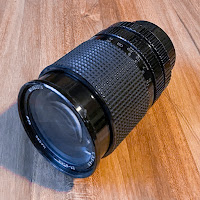When I found this lens, I had very little expectations. I presumed it was from an obscure low budget Vivitar branded camera, and it probably is. And in contrast to the Vivitar 55mm 1:2.8 Macro, heralded to be a great lens, this one is hardly known and very little has been published about it.
However, according to the Vivitar numbering scheme, this seems to be a re-branded Cosina lens, also sold under Cosina itself, under the Ricoh brand.
What make this lens so special is that the aperture ring can go two directions. One direction for manual, and the other direction for automatic (on the right camera). On a digital camera, used completely manual, both aperture directions will work. but it sure is weird to see, and it does throw you off during operations.
Aside from that, it's a front element focusing system, resulting in a very smooth focus.
After the first few pictures, shot wide open at maximum aperture, my first reaction was that this was an awful lens, possibly the worst I ever tried. But when stopped down a few steps, it really blooms. Much sharper, nice colors and contrast. Every know and then the sharpness truly impressed me.
I actually had a lot more fun playing with this lens than I anticipated, and that is still the purpose for me. Not sure if I will use it again, but it's rare, and weird enough to keep it in the collection.
Lens Specification:
Focal Length: 55mm
Maximum Aperture: F2.8Minimum Aperture: F22
Image Format: 35mm
Lens Mount: M42
Optics: 4 elements in 4 groups
Blades: 5
Focussing: Manual
Minimum Focus: 90 cm (not in Macro mode)
Filter Size: 49mm
Weight: 175g
Length: 36mm
Production: unknown
Serial Number: 97400251
Made in: Japan
More information on: Cosino
Samples
1/160 sec - ISO320 - Handheld
1/400 sec - ISO500 - Handheld
1/250 sec - ISO500 - Handheld
1/400 sec - ISO500 - Handheld
1/320 sec - ISO500 - Handheld
1/100 sec - ISO500 - Handheld
1/160 sec - ISO1600 - Handheld
1/160 sec - ISO640 - Handheld


















































